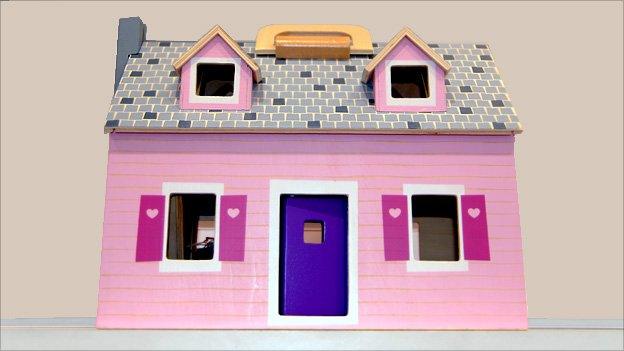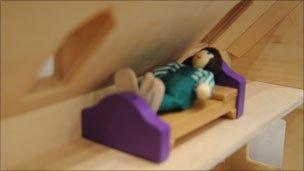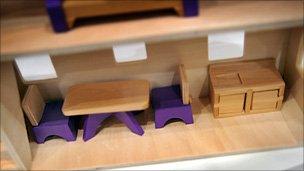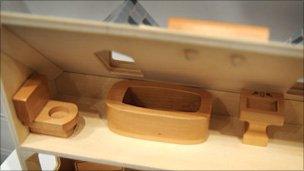The story of our rooms
- Published
- comments

How many rooms in your home? This has been a census question in the UK since 1871. But what does the number and type of rooms say about how houses have evolved over the centuries?
In medieval times, many Europeans cooked, ate, slept and socialised in one big room. By the start of the 21st Century, the average British home had 5.34 rooms, according to 2001 Census figures. Whether this has gone up or down will become clear when 2011's UK census forms are analysed.
Centuries ago, there was no such thing as a kitchen, a living room or a bedroom for anyone but the rich. There was a central hearth for warmth and to cook food, with straw-filled pallets laid on the floor for sleeping.
Over time, walls went up to divide the home into specialised areas - new rooms evolved, partly down to technology, but also to our changing attitudes to privacy, cleanliness and class.
Today, down the walls come again. Central heating and extractor fans mean we no longer need walls to keep heat in and cooking smells out.
And one room is heading for extinction, or at least being indistinguishable, says Lucy Worsley, curator of Historic Royal Palaces - the living room.
"We've passed the peak of the proliferation and specialisation of rooms which happened in the Victorian age: billiard rooms, morning rooms, parlours, studies. It was a use of space that's no longer affordable.
"The trend now is like a return to medieval living. I live in an open-plan flat with one central space. I use it for cooking, for eating, for watching TV - the modern equivalent of storytelling by the fire - and guests sleep on my sofa."
While some homes are designed to be open-plan - or are made over that way - in many new-builds there are more, but smaller, rooms, according to a study by Mike Roys of the BRE, external (Building Research Establishment). "New properties are likely to have more rooms - en suite, cloakroom, study, utility," he says.
LIVING ROOM
Aristocrats had living rooms in the Tudor period. Middling people started to get them in the 17th Century, and in the 18th Century everybody aspired to having a room purely for best. The concept of taste had arrived.
Tours of stately houses took off, and architects such as Robert Adam put out lavish catalogues of clocks and ceiling roses for the mass market.
"The living room only developed in its own right when people have the cash to splash, the leisure time to invest in a space for sitting around," says Worsley. "It's like a stage where you perform your life for the benefit of your visitors."
Even in Victorian workers' cottages, the inhabitants added decorative touches like fringing, net curtains and ceramic knick-knacks to the one room in which they cooked, ate, worked and socialised.
"You see an awful lot of keeping up with the Joneses in living rooms, whether through soft furnishings in the 1600s, new means of heating and lighting - gas and electricity - for 19th Century trendsetters, or the gadgets of today."
Average living room size has been falling since 1975, says Roys, as builders whittle away space to make room for en-suite bathrooms, utility rooms and studies.
"All of these are extra rooms because we are being told that that is what people want in a modern detached property."
BEDROOM

A room once shared with children and servants
Once communal, today the bedroom is a private retreat.
"In medieval times, your main concerns were to be warm and safe, so it was delightful to be in with other people. Since then we've seen a trend toward privacy, which started with the rise of reading," says Worsley.
"In Tudor houses we get funny little rooms called closets off the bedrooms, for praying, reading and finding solitude.
"The closet died out in English houses, but it went across the Atlantic with the Pilgrim Fathers. Today, American houses still have closets - private rooms for storing valuables. Carrie, in Sex and the City, kept her shoes in her closet, with her hopes, her dreams. That's a very Tudor thing to do."
KITCHEN

For cooking, for eating, for socialising
Once purely functional, the kitchen has been changed into a social space.
In medieval times, it was the central hearth, the heart of the home.
"Then, in the 17th Century, you get this new concept of disgust," says Worsley.
"Once there was a slight surplus of food available, people began to turn their noses up at certain foods and certain smells."
So kitchens were moved away from living areas, to keep the smell of cooking away from the noses of diners.
Grand Georgian houses had the space to shift the kitchen into a separate wing. In Victorian cities, space was at a premium and kitchens were pushed down into dingy basements.
"It's in the 20th Century that it returns to being a family space. The invention of the extractor fan is very important, it allows the kitchen and dining room to be one with clean air," says Worsley.
"And the 1980s sees the rise of the foodie - someone who loves food and cooking, and who finds the smell of bread baking, or chicken roasting, a big part of being at home.
"For others, the kitchen is meaningless - it's a place for eating the takeaway you ordered online. It has become another place to show off."
BATHROOM

Bathing is now more for meditation than hygiene
The youngest room in the house, it has only become a separate room in the past 100 years.
"People didn't used to think that going to the loo was a private matter. Samuel Pepys, in 17th Century London, had a 'closed stool' - a velvet-covered seat that stood over your chamber pot - that he was very proud of. He kept his in his drawing room," says Worsley.
At Hampton Court, built in Tudor times, there is a communal toilet called "the great house of easement", where 14 people could relieve themselves at the same time.
"It's not the technology that set the pace - the flushing toilet was invented in Elizabethan times, but it didn't really catch on for centuries," says Worsley.
In part this was because of the cheapness of labour - why plumb in water when a servant could take away your full chamber pot?
Our attitudes to cleanliness changed over time too. Once it was feared that bathing allowed germs to enter the skin; and the Victorians frowned on baths as rather degenerate.

Cleanliness became glamorous
"It really only became positive to wallow in a bath in the 1920s thanks to Hollywood, when people saw film stars drinking cocktails and talking on the telephone in a bubble bath," says Worsley.
And that set the tone for aspirational bathrooms ever since.
"Today the bathroom has the quality of the closet. People meditate in the bath. It's the one room in the house with a lock on the door. The one room you can be undisturbed by the rest of the family, and have a solitary moment."